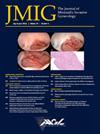“RAIL BIOPSY” A Novel and Useful Technique for Hysteroscopic Endometrial Target Biopsy
IF 3.5
2区 医学
Q1 OBSTETRICS & GYNECOLOGY
引用次数: 0
Abstract
Study Objective
Endometrial biopsy (EB) is one of the most common gynecologic procedures. Office-based EB has replaced procedures involving general/loco-regional anesthesia and cervical dilatation performed in the operating room [1, 2, 3]. The Grasp Biopsy seems to be the most appropriate EB technique for reproductive-aged women [1,2,4]. Recently, the Visual D&C performed with hysteroscopic tissue removal devices has shown to be a valid alternative [5]. However, it is often difficult to obtain an adequate specimens in peri/post-menopausal women with hypo/atrophic endometrium [2]. Our aim is to show a novel hysteroscopic EB technique called “Rail Biopsy” which requires widespread and cheap instruments.
Design
A step-by-step explanation of surgical techinque with narrated video footage. Setting: Tertiary Level Academic Hospital “IRCCS Azienda Ospedaliero-Universitaria di Bologna” Bologna, Italy.
Interventions
We performed the “Rail Biopsy” technique with a 5.0 mm Continuous Flow Operative Hysteroscope with a 30° Lens and a 5Fr operative channel. We identify the endometrial target area (ETA), and we create a first track cutting through the endometrium in a caudo-cranial direction using cold scissors. We repeat the procedure, creating a second parallel track, thus completing our “rail” and isolating a wide ETA. Then, in the caudo-cranial direction, we cut through the stromal layer beneath the ETA. With a 5Fr cold grasping forceps, we clench the cranial edge of the ETA, and we remove it from the uterine cavity. A high-quality specimen, even in the case of hypo/atrophic endometrium or focal sessile lesions, can be obtained with this technique. The crucial aspect of the “Rail Biopsy” indeed is cutting through the stromal tissue while the endometrium is minimally touched, avoiding thermal damage deriving from electrosurgery. The instruments required are widespread and cheap. Moreover, this technique can be performed on any wall of the uterus, under vision, and, in the majority of patients, in an office-setting without cervical dilatation or general/loco-regional anesthesia, making it an attractive alternative to hysteroscopy performed in the operating room setting. Further studies comparing “Rail Biopsy” to other EB techniques are needed.
Conclusion
We showed a novel approach for hysteroscopic EB that may be particularly useful in patients with hypo/atrophic endometrium, easy to learn and with low costs.
Video Abstract
Download: Download video (34MB)
Video legend. Rail Biopsy.
"RAIL BIOPSY "是宫腔镜子宫内膜目标活检的一种新颖而实用的技术。
目的:子宫内膜活检(EB)是最常见的妇科手术之一。在诊室进行的 EB 已取代了在手术室进行的全身/局部麻醉和宫颈扩张术[1,2,3]。抓取活检似乎是最适合育龄妇女的 EB 技术[1,2,4]。最近,使用宫腔镜组织切除装置进行的可视化 D&C也是一种有效的替代方法[5]。然而,对于围绝经期/绝经后子宫内膜过少/萎缩的妇女来说,通常很难获得足够的标本[2]。我们的目的是展示一种名为 "轨道活检 "的新型宫腔镜 EB 技术,该技术只需广泛使用廉价器械:地点:意大利博洛尼亚 "IRCCS Azienda Ospedaliero-Universitaria di Bologna "三级学术医院。参与者:转诊至本中心进行宫腔镜子宫内膜活检的妇女:我们使用带有 30° 镜头和 5Fr 手术通道的 5.0 mm 连续流动手术宫腔镜进行 "轨道活检 "技术。我们确定子宫内膜靶区(ETA),然后使用冷剪刀沿尾颅方向切开子宫内膜,形成第一条轨道。我们重复这一过程,创建第二条平行轨道,从而完成我们的 "轨道",并分离出宽阔的 ETA。然后,我们沿尾颅方向切开 ETA 下的基质层。用一把 5 英尺长的冷抓钳夹住 ETA 的颅骨边缘,将其从子宫腔中取出。即使是在子宫内膜贫瘠/萎缩或局灶性无柄病变的情况下,也能通过这种技术获得高质量的标本。事实上,"轨道活检 "的关键在于切开基质组织,同时尽量少触及子宫内膜,避免电外科手术造成的热损伤。所需的器械既普遍又便宜。此外,这项技术可以在任何子宫壁上进行,在可视情况下进行,而且对大多数患者来说,在诊室进行,无需扩张宫颈或进行全身/局部麻醉,这使其成为在手术室进行宫腔镜检查的一种有吸引力的替代方法。还需要进一步研究 "轨道活检 "与其他 EB 技术的比较:我们展示了一种宫腔镜 EB 的新方法,这种方法可能对子宫内膜过薄/萎缩的患者特别有用,而且简单易学、成本低廉。
本文章由计算机程序翻译,如有差异,请以英文原文为准。
求助全文
约1分钟内获得全文
求助全文
来源期刊
CiteScore
5.00
自引率
7.30%
发文量
272
审稿时长
37 days
期刊介绍:
The Journal of Minimally Invasive Gynecology, formerly titled The Journal of the American Association of Gynecologic Laparoscopists, is an international clinical forum for the exchange and dissemination of ideas, findings and techniques relevant to gynecologic endoscopy and other minimally invasive procedures. The Journal, which presents research, clinical opinions and case reports from the brightest minds in gynecologic surgery, is an authoritative source informing practicing physicians of the latest, cutting-edge developments occurring in this emerging field.

 求助内容:
求助内容: 应助结果提醒方式:
应助结果提醒方式:


